
10 tips to go digital in the tourism sector
Digitalisation is transforming the way companies do business. European tour operators and other travel businesses rely on a range of digital processes to be efficient and competitive and look for suppliers with good levels of digitalisation. The COVID-19 pandemic has accelerated the need for digital business practices as travellers demand digital communications, online sales and contactless solutions. To attract the European tour operator market, you should embed digital processes within your operations where you can, so your business has a competitive advantage.
Contents of this page
- What is digitalisation in tourism?
- Use the right tools to operate your business on a day-to-day basis
- Maintain vigilance with robust online security
- Establish a digital marketing strategy for your tourism business
- Sell tourism products online
- Make your website mobile-friendly
- Develop mobile self-guided tours for smartphones
- Gather and analyse big data usefully
- Conduct market research using online sources to build knowledge
- Interesting technologies in the tourism sector
1. What is digitalisation in tourism?
Digitalisation is defined as the use of digital technologies to manage and grow a business, which as well as selling goods and services online, includes the gathering and interpreting of big data which can help develop new activities or change existing activities. Post-COVID, embedding digitalisation will help tourism businesses to be more agile and resilient moving forward.
The rapid pace of innovations in IT over the past decade, often referred to as the Digital Revolution, has completely changed the way businesses operate. Tourism was one of the first sectors to embrace digitalisation by selling flights and hotel rooms online. The rise of OTAs (online travel agents) is one of the most dramatic examples of the digital transformation of distribution channels in the tourism sector.
OTAs are technologically advanced e-commerce platforms and have captured an estimated 40% of the total global travel market. The largest OTAs are aggregator websites like Booking.com and Expedia, which offer price comparisons and booking facilities across a range of suppliers. OTAs that specialise in selling trips, tours and experiences are another growth area and include Viator, a Tripadvisor company, and GetYourGuide.
Consumer demand for digital services across the tourism sector has also grown fast. It is estimated that more than 90% of travellers now research their holidays online. Searching online using a mobile device is becoming increasingly common, especially with younger consumers aged 18 to 34, who are twice as likely to discover travel destinations via mobile than travellers aged 35 and over.
They consult a variety of sources that include destination websites, tour operators, influencer websites, travel blogs, travel media and social media. As mobile-friendly websites increasingly become the norm, bookings by mobile device are also rising and in 2018, before the pandemic, Holiday Hypermarket (part of TUI) reported a 15% to 20% increase in mobile bookings in the first quarter of the year.
What are the opportunities and challenges of digitalisation?
Digitalisation offers multiple opportunities for SMEs and destinations to access new markets and develop new travel products and services. It is all about making sure that in this competitive world your business is optimised to target and reach the ideal customer for your product. Technology can help you do this.
Figure 1: Digitalisation in Tourism
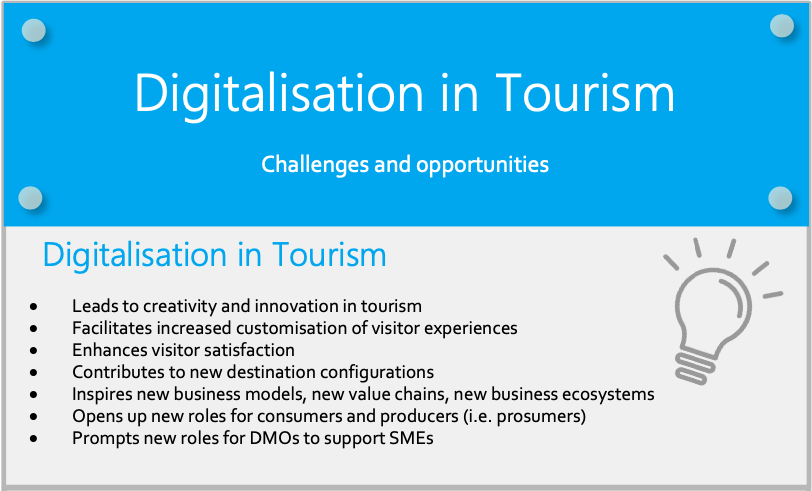
Source: Dredge, D., Phi, G., Mahadevan, R., Meehan, E. & Popescu, E.S. (2018) Digitalisation in Tourism: In-dept analysis of challenges and opportunities. Low Value procedure FRO-SME-17-C-091-A for Executive Agency for Small and Medium-sized Enterprises (EASME) Virtual Tourism Observatory. Aalborg University, Copenhagen.
Examples of digitalisation processes in the tourism sector include:
- Digitalisation of daily operations - Building digitisation into your internal business operations, such as linked calendars, email systems and automatic billing processes.
- Big data - Use of software tools to gather and analyse big data to identify a customer’s interests and tailor products to their specific needs.
- Website optimisation - Having your own website and using technology to assess performance, monitor your business’ health and optimise it for your target market.
- Social media - Managing social media accounts and planning and implementing campaigns based on insights gathered from big data.
- Mobile connectivity - Ensuring all your products and services are available via mobile devices.
- Online sales - Selling trips, tours, holidays and other experiences online, either through your own website or via an OTA, using e-commerce platforms.
- Application of new technologies – Adopting technologies like AI (artificial intelligence) – chat bots are an example here – and VR (virtual reality) – for instance, a virtual travel experience.
The process towards full digitalisation of a tourism business is a gradual one. Traditional tourism businesses have a focus on internal operations and creating value for tourists. As they move towards increased digitalisation through digital marketing and online sales, full digitalisation becomes ‘smart’ tourism with a high level of innovation, instant and real-time e-commerce and strong connections with consumers and suppliers. While this presents many opportunities, it also poses challenges.
Figure 2: Opportunities, Difficulties, Motivations and Obstacles of Digitalisation for SMEs
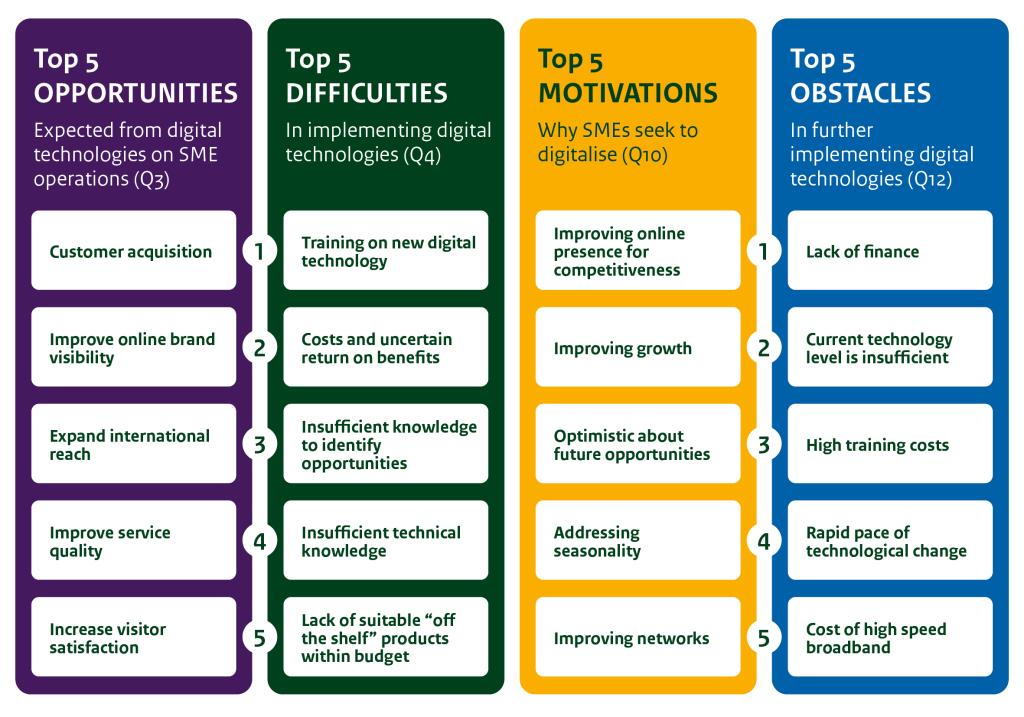
Source: Dredge, D., Phi, G., Mahadevan, R., Meehan, E. & Popescu, E.S. (2018) Digitalisation in Tourism: In-dept analysis of challenges and opportunities. Low Value procedure FRO-SME-17-C-091-A for Executive Agency for Small and Medium-sized Enterprises (EASME) Virtual Tourism Observatory. Aalborg University, Copenhagen.
Building digital knowledge, developing skills and creating new products are some of the biggest challenges. In addition, investing in technology can be costly, particularly in areas where the infrastructure is not yet available. However, there many digital activities that can be adopted as first steps as the digital environment continues to evolve.
Preparing your workforce
A key challenge for tourism businesses in the early stages of the digital transformation process is ensuring that the workforce is prepared. COVID-19 proved extremely disruptive to the travel industry and saw many employees given paid time off through government funding (furloughed), made redundant or asked to work from home. Working from home has become a key factor in digitalisation and a trend that is set to stay to a greater or lesser extent, depending on the industry.
You should familiarise yourself with the following issues:
- The basics - Ensure you and your team have a good understanding of the technologies required to operate your business. This includes digital-based office systems, your website, and social media platforms.
- Digital skills training - Providing the necessary and appropriate digital skills training to your staff is essential. Customers have increasingly high expectations of service providers. Your staff must be skilled with technology and have the right people skills to deal with the demands of tech-savvy guests and European suppliers.
- Distance working - For staff working from home, make sure you invest in the appropriate technology so they are able to do their job effectively remotely. This includes videoconferencing using tools such as Microsoft Teams or Zoom and enabling filesharing using Microsoft OneDrive, Google Drive or Dropbox. These services use the cloud, which is online storage, to securely store and share your data.
To understand more how digitalisation will affect your staff and steps to take, read this study by the OECD (Organisation for Economic Co-operation and Development), Preparing the Tourism Workforce for the Digital Future.
Tips:
- Read more about digitalisation in tourism so you fully understand what it is all about. Digitalisation in Tourism, a study conducted by Aarlborg University in Denmark is a good place to start.
- Learn from the best practices of travel industry leaders through the The 2021 Digitalisation Transformation Report by Skift in association with Amazon Web Services (AWS).
- Check out Digitalisation in times of COVID, a discussion between tourism experts on the impact of digitalisation on tourism operations, business models and employees.
2. Use the right tools to operate your business on a day-to-day basis
Managing your business efficiently on a day-to-day basis is important preparation towards full digitalisation. It will also help European buyers to know that you manage your business well and can deal with issues promptly. There are many free or low-cost digital tools available to help you run your business more effectively.
Task management systems
Figure 3: Getting Tasks Done
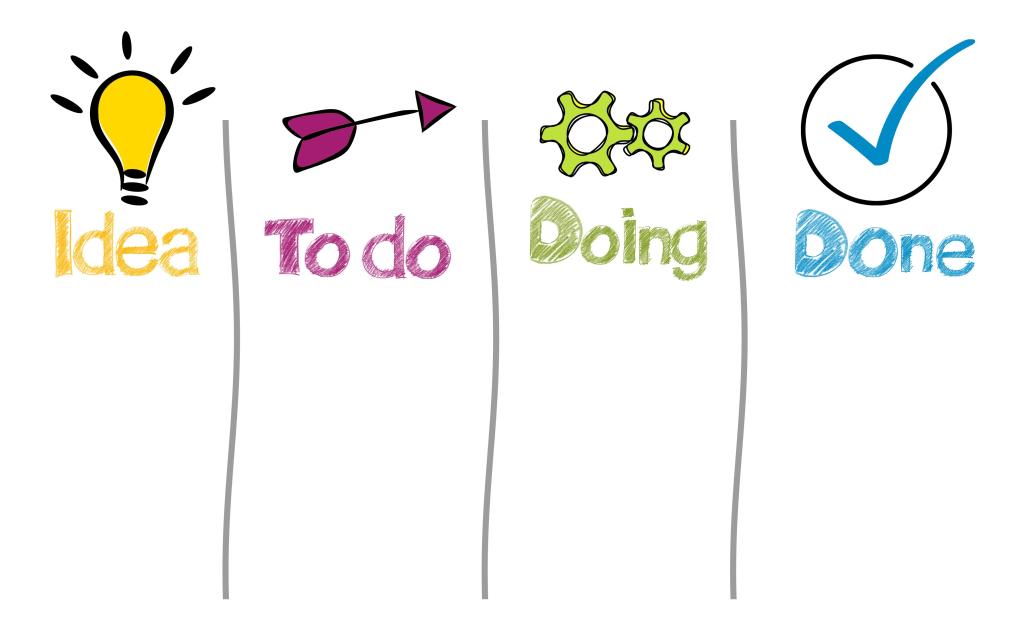
Source: Pixabay
Using a digital task management system to manage daily or regular tasks will help you and your team to maximise productivity. Task management systems usually feature a wide range of functions including:
- Creating tasks (and/or projects) that can be assigned to team members and include task descriptions, due dates and objectives.
- Scheduling of tasks on a daily, weekly, monthly or even annual basis
- Linking tasks to projects and creating visual charts and diagrams to help illustrate them.
- Project planning features.
- Enabling communication within tasks between team members, by email or as part of the program.
- Creating timesheets to allocate costs across a variety of tasks.
- Coordinating management by creating agendas and/or converting action points to tasks.
Sustainability checker
Embedding sustainability into your tourism business is fast becoming essential to attracting European buyers. Part of becoming a sustainable tourism business is understanding what sustainable actions you are currently taking and where there is room to improve. Digital tools are available to help you assess how sustainable your business is.
This Free Sustainability Check will help you find out and is based on the criteria of the Global Sustainable Tourism Council (GSTC).
Another is the online business calculator from Carbonfund.org which will help you work out your business’s carbon emissions in seven steps.
Tip:
- Read and apply the lessons from the new CBI study on how to be a sustainable tourism business to make your tourism business more sustainable.
Keep up to date with developments in blockchain technology facilitating future supply chain efficiencies
Blockchain is digital technology that improves efficiency and transparency within the supply chain. It is a type of database that contains vast amounts of information (data) stored in blocks and then chained together. This data can be accessed, filtered and analysed quickly by multiple users.
Blockchain is widely predicted to transform the travel industry. This article, What we can expect from blockchain in the tourism industry, offers insights into the potential of blockchain to bring increased safety and transparency to the sector. For more information about how blockchain technology is being used in the tourism industry, read 5 Companies Using Blockchain to Change Travel, which highlights how the technology is being adapted to improve services for customers.
Tip:
- Keep up to date with developments in blockchain technology. Blockchain, which is currently still emerging technology, originated in the cryptocurrency sector.
3. Maintain vigilance with robust online security
It is essential to keep your business and customers safe from online threats. Breaches of security due to viruses infecting your systems (ransomware or malware) and/or theft of personal data is quite common these days, and criminals keep inventing new ways to steal your data. You must ensure that any digital organisation you do business with has systems in place to keep your data safe.
Phishing uses communication links (emails, text messages) that encourage users to click links in order to infect your devices or network with a virus or take control of computers to steal data. Spear phishing is more targeted and usually addresses named individuals. You must be on your guard and ensure that your staff are too.
Make sure your internet connection is protected by a firewall to protect you against attacks, and that it is regularly updated. Research products on the market, such as those highlighted in this article, The best firewalls for small businesses in 2021. This is especially important for European tour operators, as they must comply with the General Data Protection Regulation (GDPR), European legislation governing the use of personal data. They need to be sure that you will protect the personal data they provide to you.
To find out more about GDPR, consult the CBI study on What are the requirements for tourism services in the European market.
You should ensure that you have enabled all appropriate malware protection that is provided by your email system, like spam filters. Gmail and Microsoft 365 offer good protection, but you may have to turn on some of the features.
You should also be careful about using peer-to-peer file sharing software like BitTorrent. These programs work by transferring data between a group of computers without the need for a central server and often bypass security systems.
Explore other security features increasingly used by businesses to keep their online activities safe:
- Zero trust platforms – an increasing number of organisations are adopting Zero Trust as an element or component of their trust network architecture and enterprise security strategy. Zero Trust (a Microsoft product) and Mimecast are examples of solutions available on the market.
- Secure web gateways – Some organisations have opted to access the internet through secure web gateways like Zscaler. A secure web gateway is a solution that filters unwanted software/malware from user-initiated internet traffic and enforces corporate and regulatory policy compliance.
- Multi-Factor Authentication (MFA) – refers to when a user is prompted during the sign in process to provide additional identification on their phone, such as a fingerprint or code sent to them.
Effective password management
Managing passwords that exist in your digital world is an essential management task. You should implement a password management system to ensure efficiency, clarity and safety. Passwords are often compromised these days and users are regularly warned to change their passwords. You can find out for yourself whether your email address or phone number has been compromised on this website: haveibeenpwned.com.
Instead of changing passwords regularly, use strong passwords with complexity. For example, instead of Tiger123 which is short and easy to remember, use a phrase like Tigersarenumber1greatandsplendid, which is long and complex yet still easy to remember.
In addition, consider signing up to use a password manager for business that can automatically generate and store suitable passwords, such as LastPass or 1Password.com
4. Establish a digital marketing strategy for your tourism business
Digital marketing is concerned with the marketing of products online through electronic devices. It is the easiest and most cost-effective way to reach large numbers of customers and enables you to target the people most likely to be interested in your product. A digital marketing strategy helps to establish the foundation for all digital marketing activities to ensure that activities achieve set goals and/or can be adapted as required.
A digital marketing strategy is an essential business tool to maximise the efficiency and success of a marketing campaign. Digital marketing involves the management and implementation of several elements, including:
- Website – managing your website, both the front end and analysing usage and statistics, and assessing website health.
- SEO – search engine optimisation to optimise your website so that its pages rank higher in search engines such as Google.
- Email marketing – Keeping in touch with stakeholders and customers via email (e.g. newsletters)
- Social media – managing your social media accounts and campaigns.
- Content generation – generating content from different sources, including user-generated content (UGC).
Figure 4: Elements of Digital Marketing
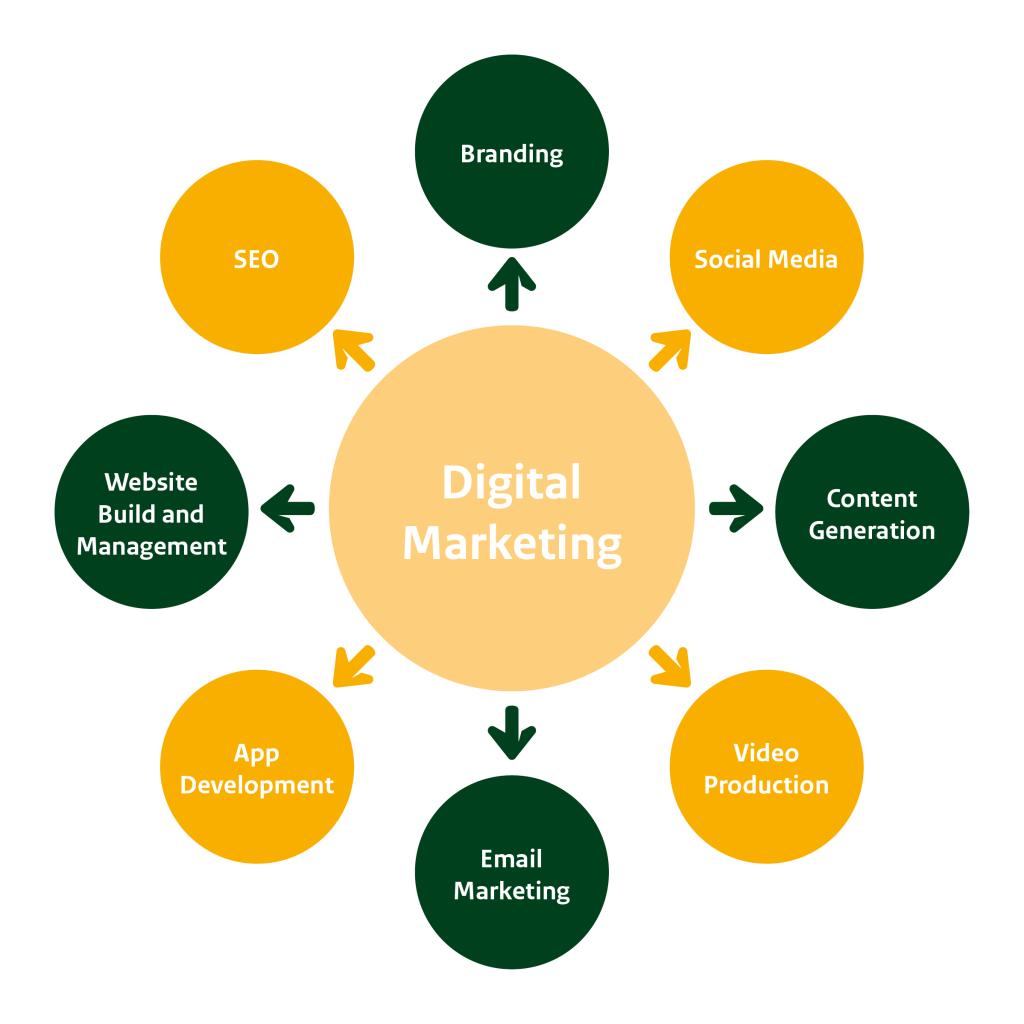
Source: Acorn Tourism Consulting
Tips:
- Read the CBI study on How to be a successful tourism company online for more information about building a website and working with OTAs.
- Invest time in learning the basics of analysing.
5. Sell tourism products online
In this digital age, more and more consumers are choosing to make purchases online. This includes travel products such as airline tickets, hotel accommodation, holiday packages, multi-day travel experiences, short trips, car hire and so on. The biggest benefit to consumers from making purchases online is convenience. The world is a busy place and having speedy transactions that instantly fulfil a need has become extremely important to customers across all consumer groups.
Being able to purchase your travel products online is especially important in the B2C market (business to consumer). The main ways of selling travel products online directly to travellers is through your own website and/or through OTAs.
In the B2B market (business to business), your website should be clear, informative and transparent so potential buyers will be reassured of the quality of your offer and want to do business with you.
Tips:
- Read the CBI study on How to be a successful tourism company online for more information about building a website and working with OTAs.
- Watch the CBI webinars on How to create effective online content and Let’s create effective online content (which focuses on online storytelling) to increase your content generation skills.
E-commerce platforms for tourism providers
To embed an e-commerce platform within your website, you should research the e-commerce solutions that exist in the market. Key features you should look for include an intuitive display of packages along with immediate online booking. It is vitally important that an e-commerce platform links seamlessly with your website to avoid any conflicts like double-booking.
Figure 5: Process of Booking Trips/Tours Online

Source: Acorn Tourism Consulting
There are several elements involved in tour operator booking systems that you should be aware of:
- Booking management – to enable you to deal with enquiries, make reservations and take online bookings from travellers.
- Itinerary creation – to enable travellers to gather information for their trip, including flight and accommodation if appropriate.
- Point of sale and payment processing – this is the sales element through which you process payment of the booking.
- Customer database and customer relationship manager (CRM) – this element enables you to keep track of your customers and what their needs are so you can target others like them more effectively.
- Reporting – to help you run your business more effectively.
- Customer reviews and feedback system – the facility for travellers to post their reviews, which will help you drive sales and increase the number of customers.
If you don’t have a website already, you can consider using an online website builder like Wix, Squarespace or Weebly, which all have a built-in e-commerce platform. There are many on the market today and you can research online to find others. Articles like this one, Top Travel E-commerce Sites Revealed, are a good place to start.
If you do have a website but no e-commerce functionality, you can sign up to a ‘bolt-on’ e-commerce platform like Trekksoft or Redzy. Alternatively, Stripe facilitates digital payment for online payments and is used by many companies, both large and small. The CBI study on How to implement online payment is also a good source of information.
Tip:
- Explore these websites and make a list of all the possible options before deciding which route is right for your business.
6. Make your website mobile-friendly
If you have your own website, it is essential that it works well on mobile devices, including smart phones and tablets. There are some interesting statistics published by We are Social that demonstrate the importance of mobile devices in the consumer world today.
- There are 5.22 billion unique mobile phone users worldwide, 66.6% of the global population. This figure grew by 117 million in 2020.
- Smartphones account for almost 80% of mobile handsets and there are 6.4 billion subscriptions worldwide.
- The number of smartphones in use is growing at an annual rate of 5.6%, and 1 million new smartphones are activated every day.
- Mobile phones are the most widely used device to access the internet, accounting for 55.7% of all web traffic.
- Most internet users (92.1%) use mobile devices to browse online some of the time, as well as also using laptops and computers.
Figure 6: Digital Usage Around the World
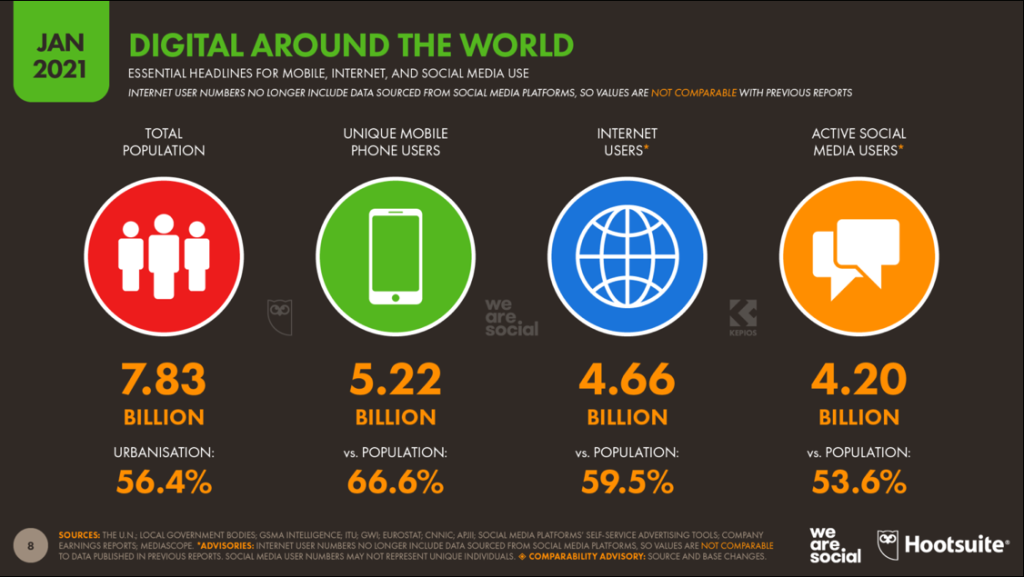
Source: 2021 Global Overview Report, Datareportal, We Are Social
Mobile technology is also evolving fast. While 4G is widely available in Europe, 5G looks set to mpact the mobile landscape and faster connections will enable richer content experiences while on the move. It is estimated that 5G will account for 50% of all mobile traffic by 2026. This means that consumers will be more demanding in terms of the quality of content they expect to be able to access on their phones while they are out and about.
To assess whether your website is mobile-friendly, ask yourself the following questions:
- How fast does your website load on a mobile device? Imagine that you are a potential customer. Would you be satisfied with your experience?
- Does your website display simply, clearly and logically? Which of the images in Figure 7 below does it most resemble? You can clearly see the difference between the two and which offers the most user-friendly view.
- Is it easy to navigate? Remember that it is harder to navigate a website on a mobile phone than it is on a laptop or computer because of its small size.
- Is it easy to respond to the call to action, like ‘Book Now’ or ‘Make an Enquiry’? Make sure as few steps (taps or clicks) as possible are needed to complete a transaction.
Figure 7: Mobile-Friendly vs Mobile Unresponsive
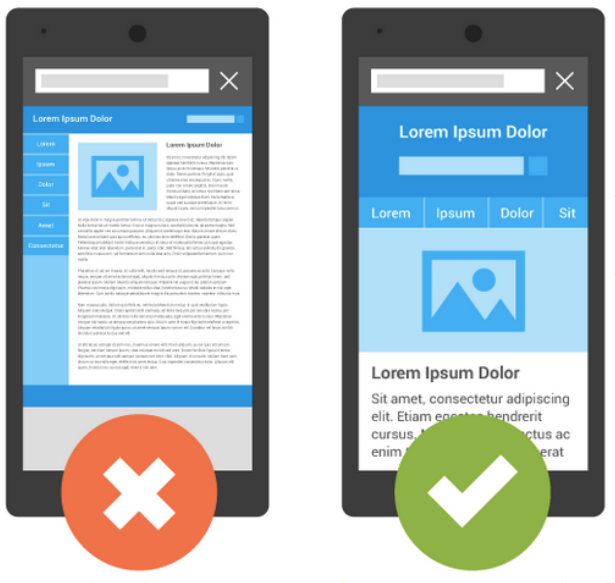
Source: Google
Tips:
- To make your website mobile-friendly, find out whether the current build can be adapted to display a mobile-friendly version of your current site. If it doesn’t, you should consider building a new one using a website builder that provides a template that is mobile responsive – most online website builders do so these days. For more information on building websites, download the CBI study on How to be a successful tourism business online and scroll to tip 5, How to build a website.
- This useful article, How to make your website mobile-friendly, gives additional detail to help you understand the steps required.
7. Develop mobile self-guided tours for smartphones
A growth area in travel app development are mobile self-guided tours (SGTs). These offer an integrated way for travellers to visit an attraction and/or destination that is cheaper and, in these times of COVID-19, a safer, socially distanced alternative to in-person group tours. SGTs are popular with travellers, as they are flexible (no fixed departure times), offer privacy and are lower cost options.
Mobile SGTs use GPS information and involve prepared itineraries downloaded onto mobile devices (usually a smartphone), and users follow a route by foot, bike, car, boat or even public transport, depending upon the tour. Usually, apps are downloaded for free and tours are available to purchase via the app at a much lower costs than a physical tour.
Examples of tour operators that have successfully developed SGTs include Sherpa Tours, which has developed more than 150 SGTs in 80 cities around the world, and includes an Augmented Reality (AR) guide, a ‘Sherpa’ in the app. Most tours are priced at around US$4.99 and some are free.
You can create your own mobile app using app builders, such as My Tours or STQRY, which has several SGT products – both operate on a monthly fee basis.
Alternatively, you can create your own tours on tour creator platforms such as Geotourist, a walking tour app centred around user-generated content, or AnyTour. Tours you create are linked to your website (which should be optimised for mobile use) through a QR code which enables the user to download the app and trail. Typically, you can list your tour for free on these platforms and they take a commission for each tour sale.
8. Gather and analyse big data usefully
Big data refers to data that is so large, fast and complex that it cannot be analysed by traditional methods and needs a technological solution to read it. In tourism, big data is typically associated with customer behaviour, opinions and habits. Data of this kind of volume is usually stored in the cloud, which is online storage managed by huge servers all over the world. Well-known examples of cloud service providers for big data include Amazon, Microsoft Azure and Google BigQuery.
Table 1: Understanding Big Data
| What big data is being collected? | What are the common big data collection methods? | How is big data collected? | How is big data used in the business environment? |
Network data collected online including social media, information and technology networks, internet, mobile networks. Real time data from streaming media, e.g. YouTube, Netflix. Transactional data from online purchases. Geographic data of people, vehicles, buildings, natural reserves. Natural language data from voice searches made on different devices accessing the internet. Time series data such as weather, mortality rates. Linked data from web technologies to enable connections between databases. | Online marketing analytics from customer information provided online, such as personal details, purchasing habits. Social media activity through video, audio, images, texts, etc. Big data tools are used to process data usefully. Loyalty programmes/ cards to build brand loyalty and learn customer habits/ preferences. Satellite imagery allows companies to continuously update information on long distances. Gameplay is a popular engagement strategy that can be incentivised to build loyalty.
| Asking for it, for instance when customers sign up for an account to make a purchase. Cookies and web beacons to monitor what pages are visited and when, to help personalise web experiences. Email tracking allows detection when an email is opened to learn users’ behavioural patterns and provide personalised advertising. | Provide better customer service to gain insights into customer behaviour, habits and preferences, so as to launch effective marketing campaigns, build brand loyalty and improve social media and online presence. Turn data into revenue by selling big data (not customer data but access to the customers). Enhanced security, particularly for finance companies, to reduce the risk of identity theft and cyberattacks. |
Source: Computool
Once collected, big data must be analysed before it can be used, and this requires sophisticated technological tools such as Hadoop, a framework for storing and analysing big data. Big data analytics companies include Cloudera (used by TUI) and Datahut.
You can read more about how TUI, one of Europe’s largest travel companies, uses big data analysis in its business model in this article, Big Data at TUI. Other European tour operators will be keen to know that you understand the importance of gathering customer data to inform your business and provide the services they need. To do business with them in the long term, it is important that you develop travel products that match the needs of their current and potential customers.
As a tourism provider, understanding your customers, what they like to do, where they choose to go and how much they are prepared to spend will give you the information you need to respond to their needs effectively. You can then make informed planning decisions and develop targeted marketing campaigns to offer packages/services tailored to your visitors’ interests. It can also help you decide the best markets to target.
Establish a CRM system
CRM systems help you manage information you gather about customers and potential customers through interactions with them, such as marketing, sales and customer service interactions, in order to build your business. CRM is key for SMEs to enable them to target and develop their travel products appropriately. You must have some form of CRM system in place to compete effectively.
Companies that offer CRM technologies include the global market leader, Salesforce, which also features products suitable for small businesses and for the tourism industry. Specialist CRM providers for tourism businesses include Moonstride, which has three packages for tourism businesses of all sizes. The platform helps to simplify and automate business, including in terms of enquires, quotations, itinerary builders, notifications, managing bookings, customer profiling and reporting.
Tip:
- Download and read this guide, The Ultimate CRM Guide for Tour Operators and Travel Agents, by travel software specialist Tourwriter. You will need to sign up to download a copy – the company collects big data!
Perform website and social media analytics
Website analytics
Your website is the first place where you should gather and analyse data yourself. Google has a number of useful tools that are free to use.
Google Analytics tracks and reports traffic to your website. It is free to use and provides information such as where your website users are based, which pages they are looking at, how long they stay on your website, what type of device they are using, and much more. You can also analyse social media statistics, which you can access through your social media accounts.
Google Trends is a search trends feature that allows you to analyse and compare popular search terms and trends. It is free to use. You can also apply filters such as location, dates and categories. Google also has Google Trends Lessons that will help you use the feature effectively. Read this blog, How to use Google Trends to gain a competitive edge, and for tips on using it to help your business.
Google Data studio is another free tool that will help you turn your data into useable content that is informative, easy to share and read and can be turned into a customisable dashboard. To find out how it works, read this post: Google’s Data Studio Help.
Social media metrics
For each social media channel you manage, you can use the built-in tools in each platform to analyse performance.
- Facebook Audience Insights – to see how people engage with your Facebook page, understand your audience and track your Facebook advertising performance. Read this blog, 6 Steps to Conduct Deep Facebook Analysis..
- Twitter Analytics – to understand the performance of your paid and organic posts.
- Instagram Insights – to learn more about overall trends across your followers and how your content performs with your audience.
There are also some companies that will manage and analyse all your social media marketing activities for you. Examples include Hootsuite and Sprout Social. They also provide lots of useful information about social media marketing online.
Tip:
- Explore the CBI study on How to forecast tourism demand with Google Trends & Data Studio for more information on using those tools effectively. The study also includes two video tutorials.
9. Conduct market research using online sources to build knowledge
Tourism associations, technology and software companies and market research organisations often produce research reports or other resources that provide insights based on big data collection, or primary research they have paid to conduct. They often spend lots of money on research, some of which they publish for free, so they may encourage you to sign up to their services.
To help you keep on top of emerging trends and insights into the tourism sector, create a directory of resources that you should consult regularly. The table below lists some that are widely used across the sector. You should consider the following groups of sources:
- International organisations and major tourism association resources – these are usually membership organisations that spend lots of money on research which is generally free for members. These organisations are also highly informed experts in the tourism industry and produce many free insights and articles about a wide variety of topics. It is worth checking out which organisations have an email newsletter you can subscribe to.
- Market research companies – there are many companies on the market, which usually have different areas of specialist expertise ranging from consumer to business research, statistics, markets, trends and insights.
- Specialists in market research, statistics and technology in the travel industry – these are businesses that specialise in services for the travel industry and adding value to these services; they often commission research which they provide for free.
- Research and insights from the travel industry – usually generated by national or regional tourist boards and/or associations. Typical information might include tourism statistics, inbound tourism insights, news reports, new developments and so on.
You can explore examples of each group in the following tables.
Table 2: Online Resources – International Organisations and Major Tourism Association Resources
| International Organisations and Major Tourism Association Resources | |
| Organisation | Details |
| Adventure Travel Trade Association (ATTA) | ATTA publishes tourism industry research and provides global news updates regularly. Some research is offered free; alternatively, you can join as a tour operator member and have access to more detailed research. |
| Center for Responsible Travel | Provides research and resources that are focused on sustainability and social responsibility in tourism. |
| International Air Transport Association (IATA) | Publishes research and economic reports (updated twice a year) for the global air travel industry. |
| Organisation for Economic Co-operation and Development Library (OECD) | Provides statistics and information for OECD member countries on a range of economic sectors including tourism. The OECD Economic Outlook is updated twice a year. |
| World Tourism Organisation (UNWTO) | The UN agency responsible for the promotion of responsible, sustainable and universally accessible tourism. The eLibrary includes more than 1,400 electronic publications and 1,700 tourism data sets on domestic, inbound and outbound tourism for more than 200 countries, which are regularly updated. Many are free to access. Other features on its website include the Tourism Dashboard and the COVID-19 Dashboard. |
| World Economic Forum (WEF) | Produces economic reports, including the annual Travel and Tourism Competitiveness Report (last published in 2019), which measures factors and policies of 140 economies that enable sustainable tourism development. |
| World Travel & Tourism Council (WTTC) | Conducts detailed research to provide consistent, reliable and comparable data and forecasts to assess the contribution of travel and tourism to national economic activity. Published as Economic Impact Reports by country, issued annually. WTTC has also developed the Safe Travels Protocols and Stamp to support safe recovery of the tourism industry. |
Source: Acorn Tourism Consulting
Table 3: Online Resources – Market Research Company Resources
| Market Research Company Resources | |
| Organisation | Details |
| CBI Tourism Market Research | Focus on supporting SMEs to attract customers in the European market. Publishes a wide range of studies focusing on niche markets and segments, along with practical guides to help do business with European tourism professionals. |
| Destinations International | World’s largest resource for destination organisations, to inform and educate members to drive economic impact, employment and sustainability. DestinationNEXT Futures Study identifies trends and opportunities that will shape the future of the industry and is published every two years. |
| Euromonitor | An independent provider of strategic market research, including tourism. Individual destination reports must be purchased, but several reports are published for free, including Top 10 Global Consumer Trends 2021. |
| European Travel Commission (ETC) | The ETC monitors sentiment for tourism, trends and prospects, European tourism trends, COVID-19 recovery, European travel portfolio analysis. |
| ForwardKeys | The global reference for business intelligence, tourism and travel trends. Publishes a range of travel insights for free. Paid for services include datasets, destination data and traveller statistics. |
| GWI | GWI is a market research company that publishes a range of reports and insights into consumer groups and habits, including market snapshots, trend reports and infographics. |
| Hootsuite | Social media management platform that publishes hundreds of free resources. |
| McKinsey & Company | Conducts wide-ranging research and publishes insights on travel, technology, logistics, infrastructure and many other industries. Articles and podcasts on trends are also available free. |
| PhocusWire | Publishes extensive daily news for all sectors of the travel industry over a wide range of topics, powered by PhocusWright, a travel research authority. |
| Sprout Social | Social media management platform that publishes many self-help guides. |
| Statista | Statistics, reports and forecasts across multiple industries, including tourism. |
| Tourism Economics | Publishes a range of free and paid for insights and reports on global travel data, forecasts and intelligence. |
Source: Acorn Tourism Consulting
Table 4: Online Resources – Specialists in Market Research, Technology and Software for the Tourism Industry
| Specialists in Market Research, Technology and Software for the Travel Industry | |
| Organisation | Details |
| AirDNA | Insights and intelligence from Airbnb. Paid for service only. |
| Arival | Market research and intelligence focused on the tour operator market. Some guides are free. |
| Redzy | Online booking software for tour and activity operators. Provides a range of free resources online. |
| Skift | Skift Research provide analysis, data and expert opinion on companies and trends shaping the industry. Access to information is provided via a mix of free and paid for news, updates, reports and research insights across the travel industry. |
| Tourism Tiger | Website design and build for tour and activity operators. Also provides comprehensive resources for the industry. |
| Trekksoft | Online booking software for tour and activity operators. Resources to help boost skills and business. |
Source: Acorn Tourism Consulting
Table 4: Online Resources – Research and Insights from Travel and Tourism Associations
| Research and Insights from Travel and Tourism Associations |
| Organisation |
African Travel & Tourism Association (ATTA) Caribbean Tourism Organisation (CTO) European Tour Operators Association Pacific Asia Travel Association (PATA) |
Source: Acorn Tourism Consulting
Tips:
- Sign up to the email newsletters of the online publications most appropriate to your business.
- Research other online publications in your destination and add them to your list.
10. Interesting technologies in the tourism sector
The diversity of the tourism industry has enabled the sector to embrace new technologies in many different areas. Artificial Intelligence (AI), Augmented Reality (AR) and Virtual Reality (VR) are all contributing to digital transformation of the sector. AR and VR are being used to stimulate interests of travellers by allowing them to take virtual tours of destinations and/or attractions.
Virtual tours are increasingly common, using technology powered by platforms such as Google’s Tour Creator and AirPano. You can see the Seven Wonders of the World, including Petra, the Taj Mahal and the Great Wall of China, visit museums, go on a digital safari, take a virtual hike or check out famous landmarks. For examples of virtual tours, see Lonely Planet’s article, The best virtual tours to explore the world from home.
Livestreaming is a trend that grew during the COVID-19 pandemic and looks set to stay. Destinations, tour operators and museums have all embraced the technology. www.explore.org is the world’s leading philanthropic live nature webcam network and documentary film channel. The website hosts live webcams at spots all over the world, providing footage of watering holes in Africa, gorilla parks, big cats, sanctuaries and much more. Feeds are streaming 24 hours a day.
To explore how to set up livestreaming, read this blog by Hootsuite, How to use YouTube Live to Engage Your Audience: A Step-by-Step Guide.
Chatbots and virtual assistants are increasingly being used by companies online to improve customer service, reduce costs and speed up response time. It is estimated that 1.4 billion people use chatbots (pop-up message boxes), and that they can answer 80% of standard questions.
Figure 8: Chatbot Statistics
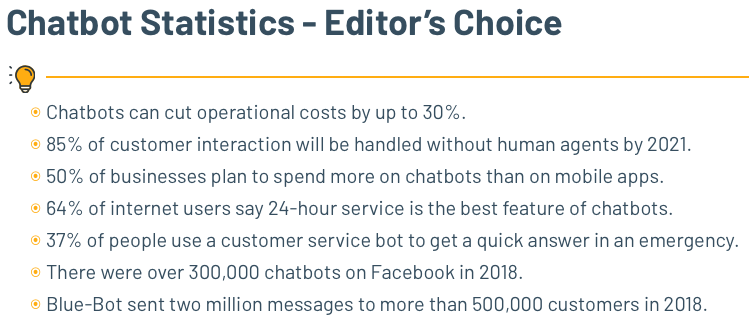
Source: smallbizgenius
SnatchBot is used by many hotels and airlines. It is compatible with all major social media channels and guides travellers through the booking process with ‘smart’ questions. Another example of low-cost chatbot builders includes MobileMonkey, a chatbot builder which has a number of templates for different industry types. It also provides a free 24/7 chatbot answering service and chat marketing tools for small businesses.
New to market in 2019, tour operator marketing intelligence software company TOMIS has developed a chatbot within its portfolio of marketing services and products for the tour operator market.
Figure 9: Example of a Chatbot

Source: TOMIS
The Internet of Things (IoT) refers to internet-enabled devices that include mobiles and tablets, but also internet-enabled devices in the home/hotel, including smart speakers like Amazon Alexa or Google Home, heating systems and appliances, and smart watches. For example, hotels can enable users to access IoT sensors in their rooms to adjust room temperatures and optimise lighting and use the technology to save energy and promote their sustainability credentials.
Figure 10: Applications of IoT in the Travel Industry
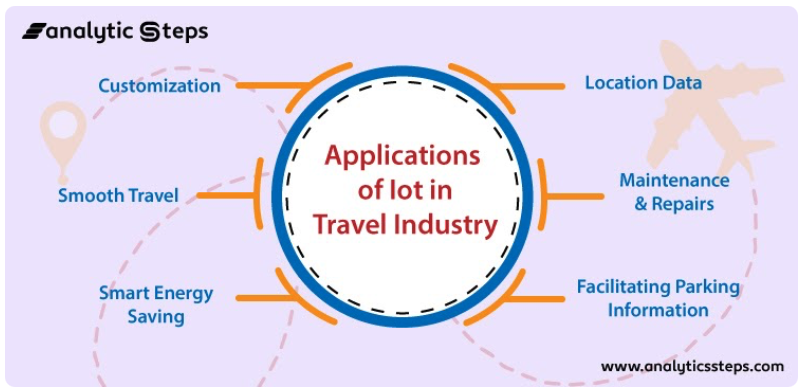
Source: www.analyticsteps.com
See these examples of technologies in action:
- The Hilton Hotel group has created an AI robot called ‘Connie’ which uses AI and speech recognition to provide tourist information to customers who speak to it. Every interaction helps to improve the service provided by the robot. Watch this You Tube Video about Connie the Concierge to find out more.
- United Airlines has incorporated smart device flight check-ins through Amazon Alexa, Google Home and Fitbit’s Iconic smart watch. The United app allows travellers to access flight status and boarding pass, available on their phone or watch.
- Some inspirational virtual tours include Machu Picchu in Peru, Museo Frida Kahlo in Mexico City, and Christ the Redeemer in Rio de Janeiro.
- Various zoos livestream to allow visitors to meet the animals, such as Chester Zoo in the UK, and San Diego Zoo in the US.
Tip:
- You should keep up to date with developments in the sector so you can adapt your business to implement new technologies when the time is right. Although some of these technologies are in early stages of development and will be expensive to adopt in the short term, it is useful to know how new digital technologies are shaping the tourism sector.
This study was carried out on behalf of CBI by Acorn Tourism Consulting Limited.
Please review our market information disclaimer.
Search
Enter search terms to find market research
